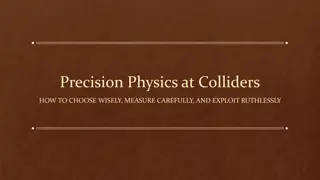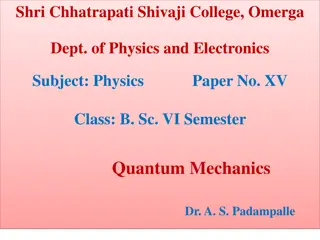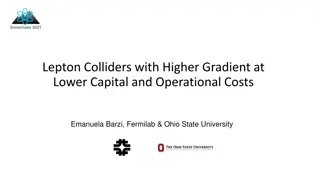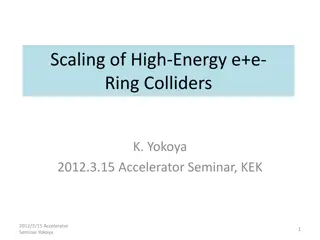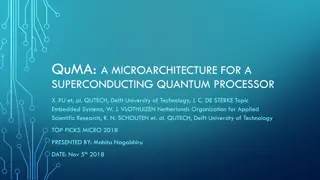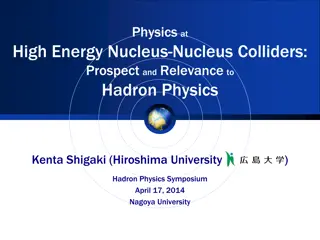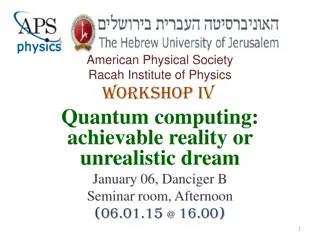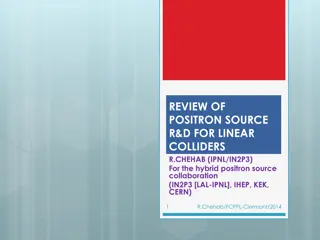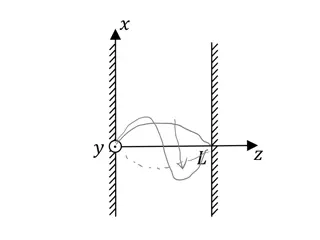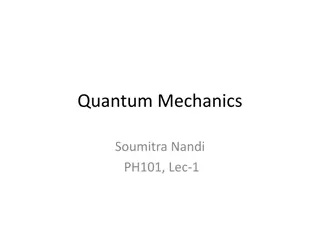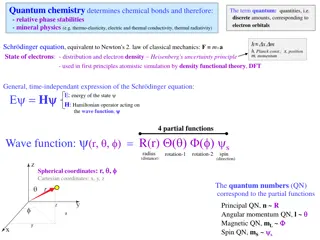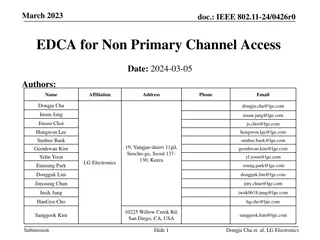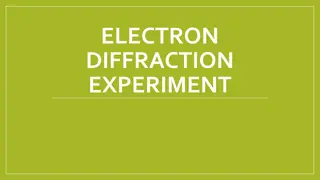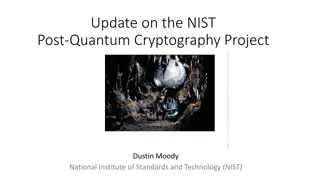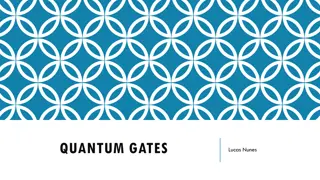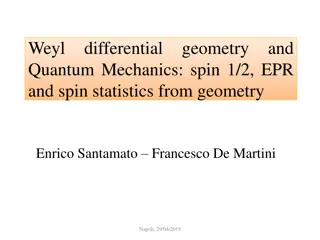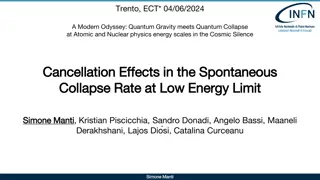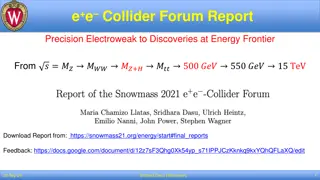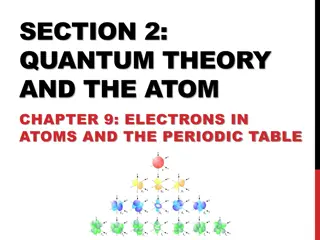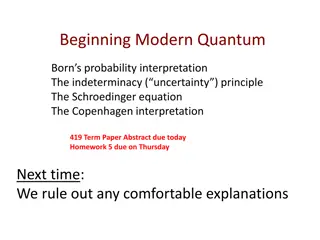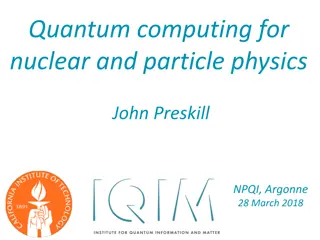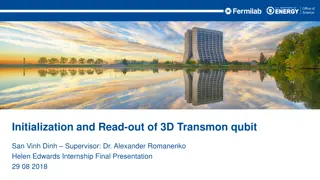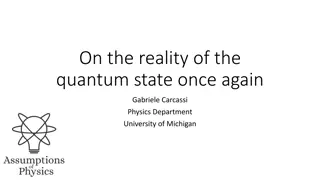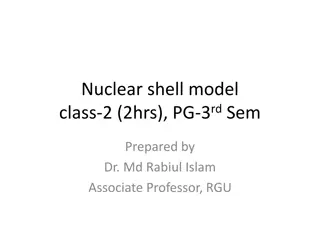Exploring State-Channel Duality in Quantum Physics for High-Energy Colliders
Delve into the intriguing concept of State-Channel Duality in quantum information theory applied to high-energy particle physics processes. Discover how quantum channels connect density matrices of particle physics states and their implications for future colliders and quantum computing implementations.
Uploaded on Oct 08, 2024 | 0 Views
Download Presentation

Please find below an Image/Link to download the presentation.
The content on the website is provided AS IS for your information and personal use only. It may not be sold, licensed, or shared on other websites without obtaining consent from the author. Download presentation by click this link. If you encounter any issues during the download, it is possible that the publisher has removed the file from their server.
E N D
Presentation Transcript
Quantum State Quantum State- -Channel Duality applied to Particle Physics* Channel Duality applied to Particle Physics* Clelia Altomonte** (she/her) IPPP Workshop: Quantum Computing for High-Energy Physics 19th-20ndSeptember 2023 C Durham *C. Altomonte, and A.J. Barr, Quantum State-Channel Duality applied to Particle Physics (2022). **MMathPhys dissertation project; King s College London, TPPC probationary PhD student.
[C. Altomonte, A.J. Barr, 2022], [C. Altomonte, A.J. Barr, 2022], Oxford MSc Mathematical and Theoretical Physics Dissertation 1
Motivation [ ] you can describe it fully in several different ways without immediately knowing that you are describing the same thing. [ ] I, therefore, think that a good theoretical physicist today might find it useful to have a wide range of physical viewpoints and mathematical expressions of the same theory. [ ] Richard Feynman 2
Outline Colliders Colliders Collidersas quantum computing implementations State-channel duality: State State- -channel duality: channel duality:SM scattering amplitudes as quantum channels, suggest a dictionary A toy model A toy model A toy model: e+e tt electroweak process with polarised beams Extensions & Extensions & applications applications: : higher order corrections, foundational tests of quantum mechanics, new regimes for QI tests 3
Colliders as quantum computing implementations Four conditions for quantum computing implementation [Nielsen and Chuang, 2010]: Condition How satisfied by Colliders a. Robustly representing quantum information PP observables (e.g. spin) and qudits Bloch vectors share group theoretic structure b. Performing a universal family of unitary transformations. State-Channel duality applied to PP (the topic of this talk) Current colliders [Y. Afik and J. R. M. de Nova, 2021] c. Preparing a fiducial initial state. Future colliders with polarised beams (e.g. CLIC) [H. Abramowicz et al., 2019] ATLAS d. Measuring the output result. 4
State-Channel duality In quantum information theory, the initial and final states of a qudit are connected through operations called quantum channels. (One or more quantum operations (where B(H) is the bounded operator B on H ) Can we find quantum channels connecting the density matrices describing the initial and final states of particle physics processes? YES, because of State-Channel duality (or Choi-Jamiolkowski isomorphism) 5
Quantum Channel State (Choi-matrix) A quantum channel = linear, completely positive, trace preserving map E : B(H) B (H ), connecting an input state space H of dimension d and an output state space H of dimension d a bipartite state of the tensor product of the input state space H and output state space H (Choi-Matrix) is isomorphic to (|0 0|) (|1 0|) (|2 0|) (|0 1|) (|1 1|) (|2 1|) (|0 2|) (|1 0|) (|2 2|) = ( ?) = ???|? ?| = ??? (|? ?|) ?? ? Properties: Related quantum channel is physically realisable iff Choi-matrix is a density matrix: 0 Completely positive iff it admits an operator- sum decomposition of the form: (?) = ?????? Which implies: . (?) 0 whenever ? 0 ??= 1 Trace preserving: ??? ?? (?) = ??? for all ? caveat: operator-sum decomposition is not unique. [A. Ekert, 2022] 6
A toy model: e+e ? ?electroweak process with polarised beams [M. Thomson, 2021] 7
PP toy-model Equations Cross-section at l.o. in the electroweak coupling constants Consider, e.g. ? Construct matrix with all 16 possible helicity combinations (suppose using polarised beams, so do not use trace techniques) Fully electric interaction Fully weak interaction 8
PP State-channel duality Quantum computing PP density matrix Identify as Choi-matrix Analyse: it corresponds to a physically realisable quantum channel Construct a quantum channel that outputs PP density matrix [IBM_quantum] with arbitrary precision (cf. Solovay-Kitaev theorem [M. Nielsen and I. Chuang, 2010] 9
Constructing quantum channels Translate obervables: (R, L) Boolean computational basis (0,1) Characterise each possible initial-final helicity state by a string of four digits. Tunable precision: Solovay-Kitaev theorem [M. Nielsen and I. Chuang, 2010] 10
[M. Thomson, 2021] [C. Altomonte and A.J. Barr, 2022] 11
[M. Thomson, 2021] [C. Altomonte and A.J. Barr, 2022] 12
Remarks and findings: constructing a dictionary translating between PP and QI Derive Identify Identify Derive 13
Serial Concatenation (QI) It submits the quantum state to subsequent quantum channels [M. Wilde, 2017]. ?: ? ? : ? ? quantum channels first channel s output ?? ??? ??????? = ?? ?? = ????? ?(?)?? = ?,? ???? ???? second channel s output ? ? ?? ? ? ? ? ? 14
Serial Concatenation (PP) PP interpretation: applicable to modelling sequential processes such as cascade decays and jets. ? ? ? ? Cf. classical algorithm (eq. 1) in [I. Knowles, 1990]. A more complex hybrid quantum-classical algorithm has been developed by [G. Gustafson, S. Prestel, M. Spannowsky, and S. Williams, 2022] 15
Parallel Concatenation (QI) Each subsystem A,B undergoes a different quantum channel [M. Wilde, 2017]. ?: ? ? : ? ? quantum channels input density operator: ??? ? ? ? parallel concatenation: ?? ? ? ? ??? = ?? ?? = ?,? ?? ?? ??? ? ? ? ? ? ? ? ? ? 16
Parallel Concatenation (PP) PP interpretation: applicable where subsystems are present and each subsystem undergoes such a process that can be regarded as independent of the state of the other subsystem, i.e. they constitute a product state that does not include entanglement. 17
Preparation channel It prepares a quantum system A in a given state ?? ? ? [M. Wilde, 2017]. PP interpetation: draw an open incoming line in a Feynman diagram ? ? ?? Appending channel It is the parallel concatenation of the identity channel and a preparation channel [M. Wilde, 2017]. PP interpetation: add a parallel line in a Feynman diagram ?? 1 ?? ? ? ? ? ?? 18
Extensions & applications Higher order corrections; Foundational tests of QM; experimental tests of QI; unitarity tests; 19
Higher order corrections PP Quantum Mechanics Quantum computing Feynman path Integral Identify unitary operator S matrix formalism Channel for overall process (total probabilities) Feynman diagrams including quantum corrections Channels for specific corrections (conditional probabilities) 20
Amplitude damping channel Tree-level: |0 ? |0 ? |0 ? |0 ? Tree-level + extra photon: |1 ? |0 ? 1 ?|1 ? |0 ?+ ?|0 ? |1 ? Higher order corrections PP interpretation: Soft Bremsstrahlung ?? ? ? ? ?? ? ? 21
Isometry: Stinesprings dilation and Krauss ambiguity Isometry: Operation that encodes a quantum state of one system into a quantum state of a larger system [A. Ekert, 2022] Let and be Hilbert spaces such that dim dim . An isometry is a linear map ?: such that V V = 1 Stinespring s dilation: arises from unitary evolution of dilated system, i.e: ? ? = tr???? where suitably chosen ancilla ? is traced out. Kraus representation (operator-sum decomposition): operators ??must satisfy normalisation (completeness) condition ??? basis for ancilla ?, i.e.: ??= 1, but depend on choice of ? ? = ????? ? [A. Ekert, 2022] 22
Stinespring Dilation and Quantum Error Correction (PP) PP interpretation: applicable to current PP research to probe confined or otherwise hardly accessible degrees of freedom (c.f. flavour physics, dark matter searches, etc.) "information on the underlying quantum process is mapped onto the state of some probe quantum system(s), and the process is reconstructed via quantum state tomography on the output states. [M. Mohseni, A. T. Rezakhani, and D. A. Lidar, 2008] Unitarity tests; [M. Mohseni, A. T. Rezakhani, and D. . Lidar, 2008] 23
testing the foundations of quantum mechanics in particle physics colliders by identifying the collider itself as a natural quantum- information processing machine provided that quantum mechanics holds. performing tests of basic quantum predictions such as entanglement and quantum state and process tomography in high energy regimes expanding theoretical modelling into regions where the Standard Model theory is difficult to calculate perturbatively, and where phenomenological models are currently employed, by having an alternative method for performing calculations does not overlap with other quantum computing protocols currently applied to nuclear and particle physics, such as quantum Hamiltonian evolution simulations 24
References H. Abramowicz et al., Top-quark physics at the CLIC electron- positron linear collider, Journal of High Energy Physics 2019 (2019), 10.1007/jhep11(2019)003. Y. Afik and J. R. M. de Nova, Entanglement and quantum tomography with top quarks at the LHC, The European Physical Journal Plus 136 (2021), 10.1140/epjp/s13360-021-01902-1. C. Altomonte, and A.J. Barr, State-channel duality applied to Particle Physics (2022) [and the references therein], https://ora.ox.ac.uk/objects/uuid:305b89aa-959c-4544-af43-8969fc4bdb31 R. Ashby-Pickering, A. J. Barr, and A. Wierzchucka, Quantum state tomography, entanglement detection and Bell violation prospects in weak decays of massive particles, (2022). A. J. Barr, Testing Bell inequalities in Higgs boson decays, Physics Letters B 825, 136866 (2022). A. J. Barr, P. Caban, and J. Rembielin ski, Bell-type inequalities for sys- tems of relativistic vector bosons, (2022), arXiv:2204.11063 [quant-ph]. A. Delgado and K. E. Hamilton, Unsupervised quantum circuit learning in high energy physics, (2022). A. Ekert, Introduction to quantum information course page, (2022) https://zhenyucai.com/post/intro_to_qi/. . M. Fabbrichesi, R. Floreanini, and G. Panizzo, Testing Bell Inequalities at the LHC with Top-Quark Pairs, Physical Review Letters 127 (2021), 10.1103/physrevlett.127.161801. M. Jiang, S. Luo, and S. Fu, Channel-state duality, Phys. Rev. A 87, 022310 (2013). M. Mohseni, A. T. Rezakhani, and D. A. Lidar, Quantum-process tomography: Resource analysis of different strategies, Physical Review A 77 (2008), 10.1103/physreva.77.032322. M. Nielsen and I. Chuang, Quantum computation and quantum information (Cambridge universitypress, 2010). M. Thomson, Modern Particle Physics (Cambridge University Press, 2021). M. Wilde, Quantum Information theory (Cambridge University Press, 2017). S. L. Wu, et al, Application of quantum machine learning using the quantum variational classifier method to high energy physics analysis at the LHC on IBM quantum computer simulator and hardware with 10 qubits, Journal of Physics G: Nuclear and Particle Physics 48, 125003 (2021) IBM Quantum https://quantum-computing.ibm.com/lab 25




